Small Home Gazette, Spring 2011
An Arduous Task
Did you know April 19, 2011, was National Hanging Out Day? When I was a child in the 1950s, one of my tasks was to hang the laundry outside. I can remember gathering the sheets in my arms to get a whiff of that wonderful fresh smell.
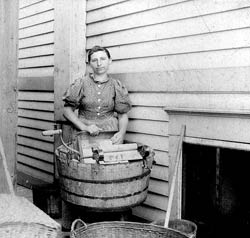
Washing Clothes in the Good Old Days
Washing clothes used to be difficult, back-breaking work. For example, in the 19th century, removing soap and water was a separate process after washing. The soaking wet clothing would be formed into a roll and twisted by hand to extract water. About 1860, the wringer was developed, which used two rollers under spring tension to squeeze water out of the clothing as each piece was fed through the wringer separately.
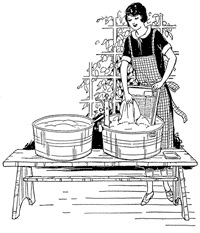 The first wringers were hand-operated, but by the late 1870s were included as a powered attachment above the washer tub. The wringer would be swung over the wash tub so that extracted wash water would fall back into the tub to be reused for the next load.
The first wringers were hand-operated, but by the late 1870s were included as a powered attachment above the washer tub. The wringer would be swung over the wash tub so that extracted wash water would fall back into the tub to be reused for the next load.
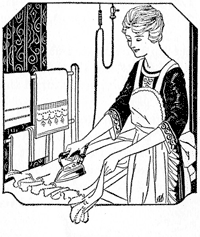 The Victorian-era home laundress often continued to use older equipment along with some new. The laundry room would probably have been outfitted with tubs (portable or stationary), wash benches to hold portable tubs, washboards, wringers, boilers with lids, clothes baskets, an indoor clothesline (one style wound up inside a metal container attached to the wall to keep it clean and out of the way), ironing board and iron, and various other items to help with the laundering process and, eventually, a washing machine.
The Victorian-era home laundress often continued to use older equipment along with some new. The laundry room would probably have been outfitted with tubs (portable or stationary), wash benches to hold portable tubs, washboards, wringers, boilers with lids, clothes baskets, an indoor clothesline (one style wound up inside a metal container attached to the wall to keep it clean and out of the way), ironing board and iron, and various other items to help with the laundering process and, eventually, a washing machine.
Enter the Washing Machine
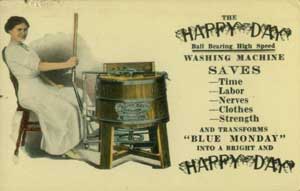 With the introduction of the washing machine in the early 1900s, “mechanized washing” made things a bit better. Sears Roebuck offered a variety of washing machines (all operated by hand) in its 1902 catalog. Complete with a guarantee that the machine would not damage clothing, prices ranged from $2.72 to $5.62 (in today’s dollars that would be $78.27 to $161.73). Electric washers (called “self running”) were next, but it was not until the 1920s that they became more affordable.
With the introduction of the washing machine in the early 1900s, “mechanized washing” made things a bit better. Sears Roebuck offered a variety of washing machines (all operated by hand) in its 1902 catalog. Complete with a guarantee that the machine would not damage clothing, prices ranged from $2.72 to $5.62 (in today’s dollars that would be $78.27 to $161.73). Electric washers (called “self running”) were next, but it was not until the 1920s that they became more affordable.
Washer design improved during the 1930s. The mechanism was now enclosed within a cabinet, and more attention was paid to electrical safety. Spin dryers were introduced to replace the dangerous power wringers of the day.
Spinning requires a constant high-speed power source, and was originally done in a separate device known as an extractor. What is now referred to as an automatic washer was at one time referred to as a washer/extractor, which combined these two features into a single machine, plus the ability to fill and drain water by itself.

Early 1900s Machine Milestones
1907 – Manually-operated wooden-tub machine produced by Maytag Corporation
1908 – First electric washing machine (called the “Thor”) introduced by Hurley Machine Company
1911 – Production of electric motor-driven wringer washers by Whirlpool Corporation
1915 – First electric tumble dryers appear
1928 – U.S. sales for washing machines hits 913,000 units
1934 – First laundromat opened in Fort Worth, Texas
1937 – First automatic washing machine (wash, rinse and extract water in one operation) invented by Bendix Aviation Corporation
1940s – First electric dryer with glass window developed
1947 – First top loading washing machine introduced
A Domestic Art
The 1931 book Laundering and Dry Cleaning, Woman’s Institute of Domestic Arts & Sciences, included a plan for organizing laundry work as well as tips for hanging out clothes in cold weather.
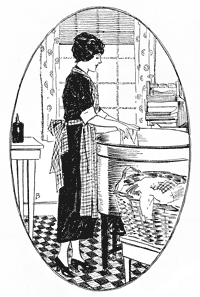
(Excerpt begins)
Monday:
- Sort clothes.
- Mend tears that will grow in washing.
- Remove stains.
- Soak soiled clothes.
- Get equipment ready.
Tuesday:
- Heat water.
- Make soap solution.
- Fill tub or washer and wash in succession (changing suds when necessary): table linen, bed linen, towels, body linen, handkerchiefs, soaked clothes.
- Boil by putting clothes in cold water and letting them slowly come to boiling point.
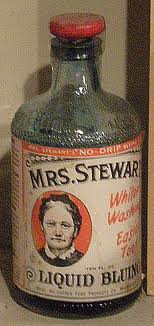 Make starch.
Make starch.- Look over articles, especially if a washer has been used, to see whether further rubbing is necessary.
- Rinse in 2 or 3 waters.
- Blue, dipping and wringing each piece separately. (Editor’s note: In the early and middle 1900s, bluing was used as additional rinse to whiten items. Bleach helped to remove stains; bluing counteracted the rest of the “yellow.” Bluing contains a blue dye or pigment which, once taken up by fabrics in the wash or rinse, creates an optical illusion by absorbing the yellow part of the light spectrum.)
- Starch clothes needing average stiffness, changing starch as often as necessary.
- Hang out pieces.
- Wash colored clothes, setting color, washing, rinsing 2 or 3 times, starching; and hang out to dry.
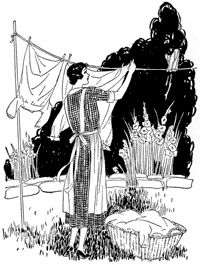 Wash cotton stockings, rinse, and hang to dry.
Wash cotton stockings, rinse, and hang to dry.- Take down clothes, piece by piece, fold and lay in the basket.
- Dampen and roll up.
- Wash any silk underwear, embroidery pieces, or colored clothes that must be ironed immediately, and iron. Also, wash flannels and wool or silk stockings.
In freezing weather, wash the clothesline and pins with strong salt water and do not rinse it off. The salt will prevent the clothes from freezing to the line.
To keep the clothes in the basket from freezing before they are hung up in winter, fill a metal hot-water bottle with very hot water and place this on top of the basket. As the clothes begin to freeze, push the bottle from place to place. This will warm the hands as well as stop the freezing.
A small-sized rubber hot-water bottle carried in the clothes-pin bag will add greatly to the comfort of winter laundry work.
(End of excerpt)
Those winter-related tips might come in handy in Minnesota. (I remember bringing in items that had frozen stiff and marveling that, when thawed, they were dry.) There IS a tip from my mother I would add—whatever the time of year, hang the undies so that they cannot be seen by the neighbors!
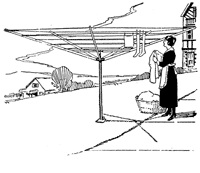 Maybe you still have the remnants of the old clothesline. In prepping the exterior of our bungalow for stucco repair, we removed a set of four hooks in the back wall. These hooks were one anchor point for a clothesline from the past; the other side was probably a set of hooks anchored in the garage or maybe in a pole set in the ground. Or you might have a pole in the back yard that once supported radiating arms from which to string rope (think inside-out umbrella).
Maybe you still have the remnants of the old clothesline. In prepping the exterior of our bungalow for stucco repair, we removed a set of four hooks in the back wall. These hooks were one anchor point for a clothesline from the past; the other side was probably a set of hooks anchored in the garage or maybe in a pole set in the ground. Or you might have a pole in the back yard that once supported radiating arms from which to string rope (think inside-out umbrella).
Since nice weather is coming our way, why not hang your clothes out to dry? Here are some good reasons.
- Hanging clothes outside cuts down on energy costs; it is a green thing to do.
- The sun acts as a natural disinfectant. The sun’s UV rays have been proven to help kill bacteria.
- Clothes will actually last longer. Putting them in the dryer creates lint and weakens fabric over time.
- Don’t clothes just smell better when they are hung out?
Project Laundry List is an online resource for those who want to wash in cold water and air-dry laundry: www.laundrylist.org.
A Serious Evil to Washerwomen
I still have my mother’s clothespin bag, mostly full of the wooden pinch style with a metal spring mechanism.
![]() Invented in 1853 by David M. Smith of Vermont, it is a tried and true design. In his patent papers, Smith explained his design rather stiffly:
Invented in 1853 by David M. Smith of Vermont, it is a tried and true design. In his patent papers, Smith explained his design rather stiffly:
“By pushing the two superior [upper] legs together the inferior [lower] ones are opened apart so that the instrument can be safely placed on the article of clothing hanging on the line. This done, the pressure of the fingers is to be removed so as to permit the reaction of the spring C to throw the inferior legs together, and cause them to simply grasp the piece of clothing and the line between them.” The clamp’s benefits: “This instrument unlike the common wooden clothes pin in common use does not strain the clothes or injure them when it is used.” Furthermore, he triumphantly concluded, “it cannot be detached from the clothes by the wind as is the case with the common pin and which is a serious evil to washerwomen.”











